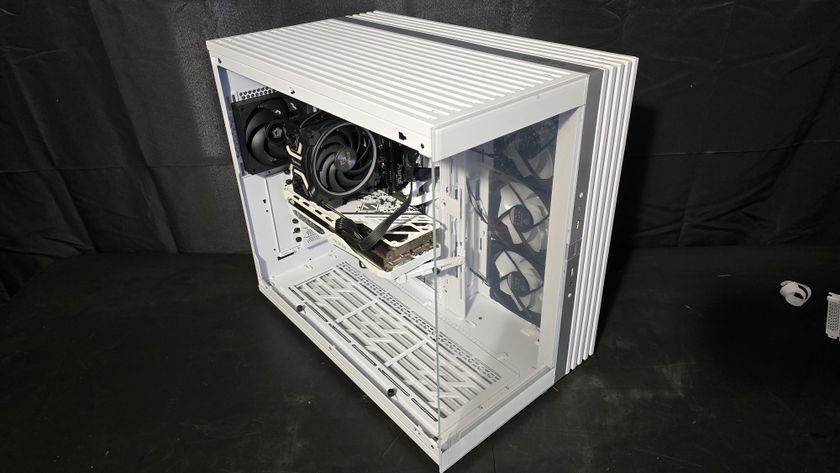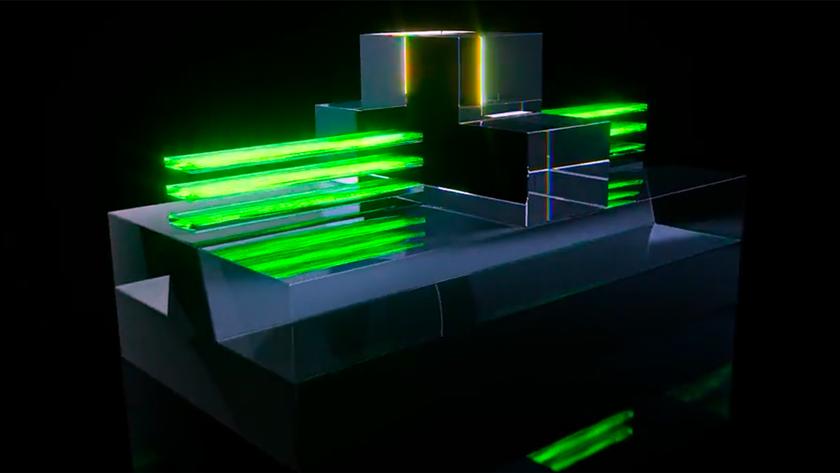ID-Cooling Stream Case Integrates Part of Custom Liquid Loop
ID-Cooling's new Stream series cases incorporate part of custom liquid loops in the chassis structure, which begs the question: are the cases themselves liquid cooled?

Normally, a computer case is something that houses your hardware. That seems like quite an obvious statement, but ID-Cooling had a different idea about that at Computex this year. Instead, it integrates liquid cooling into the case, and we’re not talking about simply supporting liquid cooling hardware. Fluid actually flows through the chassis.
Meet the ID-Cooling Stream series.

Calling these units cases would be a liberal use of the word, however. They’re completely open, offering just a frame and some mounting points for your hardware, so maybe the term chassis is more fitting. Along the perimeter of each side of the frame runs an aluminum tube. Each has a handful of G1/4” threads into which you can route water cooling. Fluid for the cooling loop actually flows through the frame of the chassis.

ID-Cooling built four variants of the case to show off, and they are creatively named the Stream 1 (top left), Stream 2 (top right), Stream 3 (bottom left), and Stream 4 (bottom right).




The Stream 3 is built for up to ATX motherboards with two dual-slot graphics cards up to 267mm long, one 3.5” hard drive and one 2.5” SSD. For cooling it has four water loop connectors and up to 360mm radiator support.
Stream 1 and 2 have six water cooling connectors each, along with space for a 240mm radiator. The Stream 2 also supports an additional 120mm radiator, and both have room for two 2.5” SSDs. The Stream 1 has room for one 267mm long dual-slot graphics card, whereas the Stream 2 offers room for two 280mm long dual-slot cards. Both can house up to micro-ATX boards.

Finally, the Stream 4 is built for mini-ITX systems, has room for one 280mm dual-slot graphics card, two 2.5” drives, and has four G1/4” threads and can accommodate a single 240mm radiator.
Stay On the Cutting Edge: Get the Tom's Hardware Newsletter
Get Tom's Hardware's best news and in-depth reviews, straight to your inbox.

To say that the cases are functional would be a wild overstatement. They don’t have dust filters, no noise damping, and cable management is near impossible (although we did suggest to ID-Cooling to also route cables through the chassis tubes). But they do truly show off your gear and allow you to build some really neat systems.

Most concepts like these are called concepts for a reason, but this one will actually live on. In fact, Stream 1 and 2 are already in mass production and will be available for purchase by the end of the month for $269.99 and $299.99, respectively. You won’t be able to buy them in shops though; ID-Cooling doesn’t have a U.S. distributor yet, so for now you’ll have to buy them through the company's eBay store. The Stream 3 and 4 will come later and also haven’t been priced yet.
Follow Niels Broekhuijsen @NBroekhuijsen. Follow us @tomshardware, on Facebook and on Google+.
Niels Broekhuijsen is a Contributing Writer for Tom's Hardware US. He reviews cases, water cooling and pc builds.
-
Gam3r01 For these cases being so "advanced", those TIG welds look fairly poorly done. Not what you should be seeing for that price tag.Reply -
sillynilly Agree the welds look horrible. I do like the idea though and the shapes, colors look pretty cool. Although making one yourself out of tubing wouldn't be too difficult if you really wanted to.Reply -
kyle382 Wow these are beautiful. I just wish the stream 2 was smaller. Too much dead space as it is.Reply
-
kyle382 Wow these are beautiful. I just wish the stream 2 was smaller. Too much dead space as it is.Reply
-
jasonelmore yeah the tig welds need to be grinded down or done by a machine to make them uniform. these look like a high schooler did them in shop class.Reply -
Gam3r01 Reply18055819 said:yeah the tig welds need to be grinded down or done by a machine to make them uniform. these look like a high schooler did them in shop class.
I, as well as much of my Welding 1 class in high school, could have done better.
I personally think its fine to leave them, as long as they look uniform. -
falchard One of the unintended design features of my inWin 904 case with a radiator attached to it is it acts as one giant heat sink. When I am pushing the CPU, the aluminum in my case gets very hot. This looks interesting.Reply -
FallenKell I would think they need to worry about galvanic corrosion. Not all water blocks are going to be use aluminium and the same with the radiators. By having the dissimilar metals corrosion will be a problem over time.Reply -
Lutfij Niels,Reply
I for one would like to know the internal construct of the chassis simply because those chassis look to be one time use builds due to galvanic corrosion incurring within your loop.












